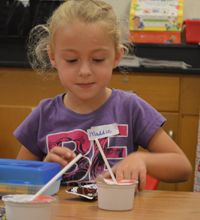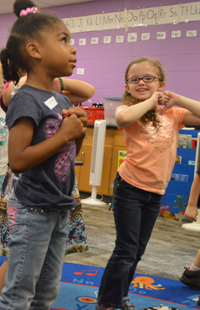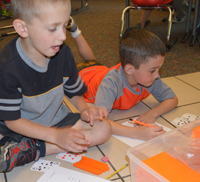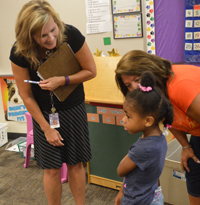Byron Center’s Brown Elementary School kindergarten students are seated on a carpet in a big circle fronting a white board. They are making sense — “number sense” that is.
Teacher Andrew Smith writes the number 912 on the board and asks students what they know about it. Their answers demonstrate math comprehension, or “number sense” in elementary lingo, which Smith has been working to instill.
“I know how to build this number,” says Lauren Gottschalk, explaining symbols that represent nine 100s, one 10 and two ones.
Related Story: Is Play Still a Kindergarten Expectation? – Ask any parent of a dinosaur lover who can identify an Apatosaurus at age 3 if learning occurs during play, and the answer is an obvious “yes.” But with the added work on kindergartners comes less time for leisure, and one of the biggest differences in kindergartners’ school life is the decrease in free playtime…
“I know that 900 plus 10 plus 2 equals 912,” says Nolan Martin.
“I know that the two is in the ones place and the one is in the 10s place and the nine is in the 100s place,” says Olivia VanderLaan.
“I know that 912 plus one subtract one equals 912,” says Sarin Leale.
“I know 1 million 912 subtract 1 million equals 912,” says Riley Hanley.
“I know 9,912 subtract 9,000 equals 912,” says Bishop Pelton.

Kindergarten: Version 2016
Smith’s students and kindergartners nationwide work at a level formerly seen in older grades as more and more curriculum has been added to kindergarten classrooms.
“Oh my gosh, these kids are practically doing what my second-graders were doing when I taught second grade,” Smith said. “I feel like this group moving forward has a strong foundation to build upon and to be successful later on down the line. … They inspire me.”
Contrast Smith’s class to kindergarten circa 2000. Picture a room with a big play area and a smaller space for academics. Children take breaks to sort blocks and dress dolls, they sing and play musical instruments. They learn letters and sounds, but not words yet. They write their names and draw. Math means counting and shapes. Students attend half days, morning or afternoon, leaving plenty of non-school hours in their day.
“The thing we have to remember is the kids are still 5. They haven’t really changed.” –West Grandville Elementary School teacher Stacey Byl
Now consider how starkly different today’s kindergarten looks. Gone are graham cracker-fueled days focused mostly on socialization, helping children become comfortable being away from Mom or Dad, learning ABCs and 1-2-3s, and maybe even napping on the floor.

Post-millennial kindergartners face a lengthy list of standards to check off before first grade. They learn to read dozens of words. They finish the year knowing how to write a completed paragraph. In math, they learn place value, addition, subtraction and word problems. They take computerized tests to measure reading and math skills. Teachers submit data on the test results, which are considered in their evaluations by administrators.
Critics, such as the Alliance for Childhood, say children are faced with too much too soon. They worry that important areas needed for development, like good old-fashioned play, are pushed aside and dismissed as a waste of time. They worry that school-fatigue will set in fast, and point to less-structured, more playful systems like Finland’s as healthier models.
Others, however, say academic-heavy kindergarten is necessary to set a foundation for the rigors to come in first grade and beyond. Plus, they say, students are able to meet new expectations in astounding ways.
Kindergarten started shifting academically about 15-20 years ago, said Teresa McDougall, Kent ISD instructional coach for teaching and learning. “We were learning more about the brain and understanding that the students were capable of more than what we were providing.”
Students could read and do math at higher levels, McDougall said. So teaching them more makes sense, but it must be done in ways students grasp and enjoy. Most teachers already knew that and have enhanced their teaching using various methods, she said. That way, they are using several avenues to help students understand concepts previously thought too advanced.
“Teachers or researchers will say it needs to be developmentally appropriate,” McDougall said. “Developmentally appropriate is the how we teach, not necessarily what we teach.”
Former Brown Elementary School Principal Barb Johnson, now Byron Center district administrator for teaching and learning, said kindergarten has had to adapt to align with future expectations, including third-grade reading fluency — a prime focus of student-achievement standards.
“The kids can do it because they are ready,” Johnson said. “They probably could have long ago and would have. The need wasn’t there or I don’t think we understood the need as well. Now we know this world is changing and the depth of understanding of their reading has to be very strong.”

In Comes Common Core
While the shift toward increased rigor was already occurring, teachers say it skyrocketed five years ago with implementation of the Common Core, the U.S. initiative that seeks to establish consistent educational standards across the states. Those standards build on each other from kindergarten through 12th grade.
At first, the expectations seemed daunting, said Stacey Byl, a kindergarten teacher at Grandville Public Schools’ West Elementary.
“There was immediate panic on the part of almost all kindergarten teachers,” Byl said, describing the standards they were used to meeting at the time: a little reading and writing, numbers, counting and basic shapes.
“Common Core has completely changed that. Kids have to read twice as high as what they were expected to read before. In order to read at that level they have to know so many more words. They have to write. The standard is technically a paragraph.”
Upped expectations coincided with Michigan public schools’ switch to full-day kindergarten five years ago. Byl was excited to have time to cover more with her students, but knew she had to take a different approach. “I was like, how can I keep these little people tuned in for a full day?” she said.
Keeping Students Interested and Active
Byl started researching whole-brain teaching, an instruction program that incorporates lots of movement, conversation and repetitive language. (See SNN article on whole brain teaching.) She is now a certified teacher and trainer in the technique and has helped many West Michigan elementary teachers, including in Grandville, learn a method she has captured on video.
“We do a lot of moving your whole body, talking,” Byl said. “We actually say we are using all parts of our brain — including the fun part.”
That’s the key, she said. Students have to want to be in kindergarten because it’s hard to keep them on task all day.
“The thing we have to remember is the kids are still 5,” Byl said. “They haven’t really changed. One of the things I love about whole-brain teaching is the kids are having fun and they are able to still be the active little souls that they are.
“Treating them like third-graders would not work.”
Following a recent kindergarten orientation, Wyoming Public Schools’ West Elementary teacher Julie Merrill, who has taught kindergarten most years since 1997, explained how she has adapted to new standards over the years — while keeping in mind that students must be taught in age-appropriate way.
“There’s so much work involved in being a kindergarten teacher,” Merrill said. “You have to plan for somuch just to keep these kids engaged and wanting to come to school.”
Her children are constantly moving, dancing, singing and conversing while still fitting in 90 minutes of reading per day, math focused on “number sense,” and hands-on science projects that align with the new Next Generation Science Standards. (See SNN article on Next Generation Science Standards in Kindergarten.)
“I never have a 5-year-old sitting for more than 15 minutes,” Merrill said.

‘We’re Asking A lot’
Comparing her students’ achievement in half-day kindergarten five years ago versus full-day today doesn’t work because the standards are so different, Byl said. But she sees what her students are doing now and it amazes her.
“My kids are able to write a topic sentence, three details and a conclusion. Even some of my struggling students can do that. But it has to be fun. I keep telling teachers, ‘You have to make it fun or they’re not going to want to do it.’”
Grandville Public Schools, like several other districts, offers half-day Young Fives classes, typically for students whose birthdays fall between May and September. Students take Young Fives as an extra year between preschool and kindergarten. (Beginning last school year, Michigan children had to turn 5 by Sept. 1 to enroll in kindergarten, but parents can sign a waiver for students who turn 5 by Dec. 1, which was the cutoff date until three years ago.)
Grandville also offers a two-year-kindergarten program called “looping,” which allows students to stay in kindergarten for two years if they struggle.
“I work really hard to make a community of caring and friendly 5-year-olds. That used to be what kindergarten was. That used to be the total purpose.” — Wyoming West Elementary School teacher Julie Merrill
Byl said these are great options for students not quite ready for kindergarten academics, because more than anything else, Byl wants them to be happy and to like school.
“Our goal is not to make kids suffer through kindergarten. It’s very important to me that they start off school with a positive experience.”
Byron Center’s Johnson said teachers are using techniques to make classrooms a place of discovery filled with “purposeful play” structured around reading and math.
“That’s the teacher’s joy and challenge to make learning fun,” Johnson said. “The children are such sponges and so receptive and eager learners in kindergarten. They wonder about the world so much and the are seeing everything for the first time. It’s a great time to stretch their thinking.”
‘She Definitely Loves School’
Parents with students entering kindergarten at Wyoming’s West Elementary said they welcome academics that are also made fun. Several asked Merrill during orientation two weeks before school started for the list of “sight words,” words students will learn to read this year.

Anna Burton, mom to student Madison Burton, said kindergarten will be an adjustment, but her daughter’s ready for it. “She definitely loves school.”
“She knows how to write words and everything. She knew how to write her first, middle and last name by the end of the first week in preschool,” Burton said.
Jennifer Langlois, mom to Evan Thompson, said she looks forward to her son reading and writing. “I want him to learn new things because he loves learning and he’s very smart. Anything that makes learning fun for him is the best.”
In Merrill’s classroom, it looks like Anna, Evan and her 18 other students are off to a great start. When Merrill met kindergartners who walked into her classroom for the first time, she was already getting know them. She asked each child about their favorite thing and wrote the answers on her class list: “Spiderman. Hulk. Painting. Swimming.”
In the busy days of kindergarten, these things still matter, she said.
“To me the biggest key to success is building relationships with kids and families,” Merrill said. “That supersedes everything I am going to teach them on a piece of paper every single time.”
CONNECT
Common Core Kindergarten Literacy Standards
Common Core Kindergarten Math Standards









